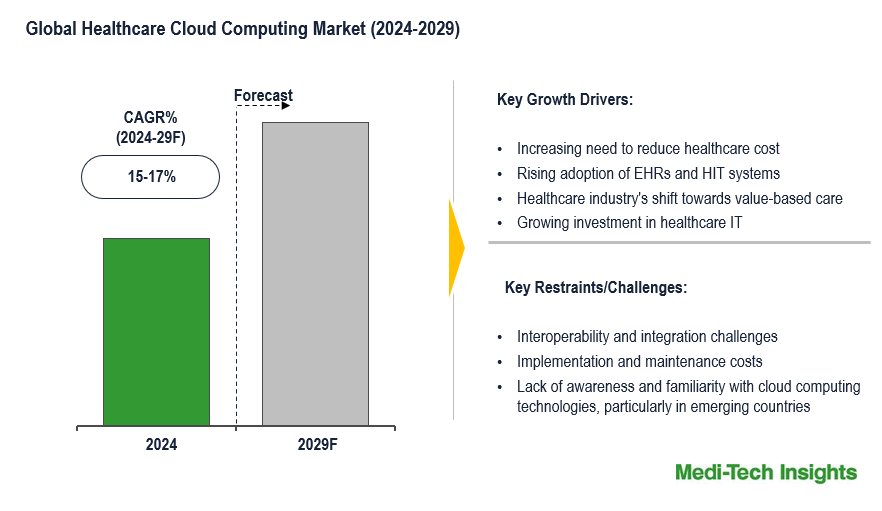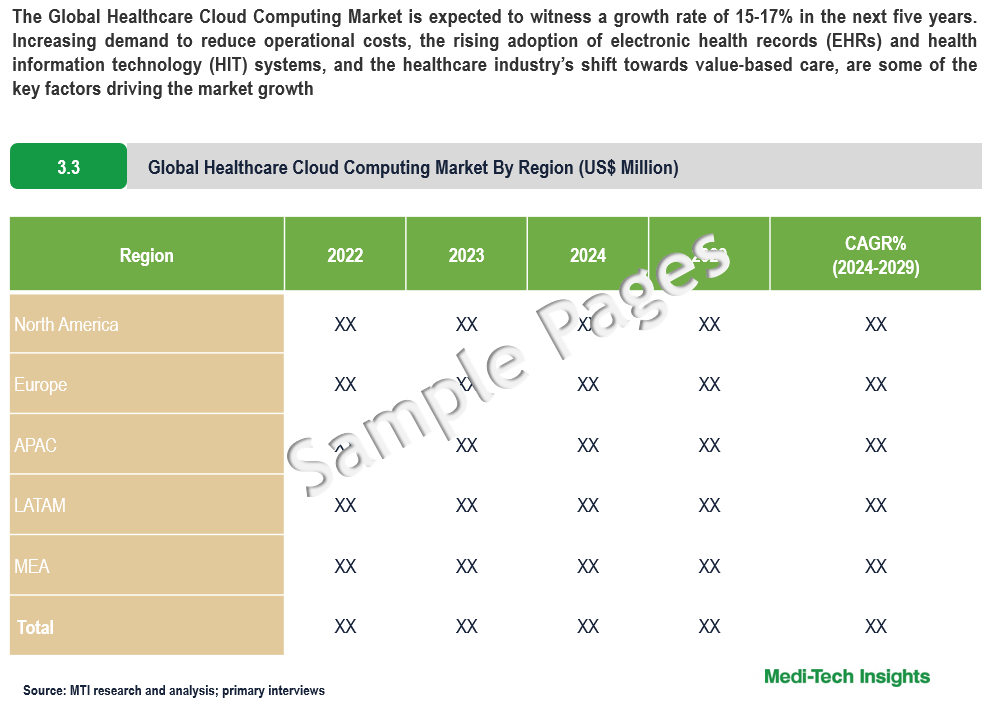
Healthcare Cloud Computing Market Size, Share, Trends and Growth Opportunities for Forecasts 2024 to 2029
The Global Healthcare Cloud Computing Market is expected to witness a growth rate of 15-17% in the next five years. The healthcare cloud computing market is experiencing growth driven by increasing demand to reduce operational costs, the rising adoption of electronic health records (EHRs) and health information technology (HIT) systems, and the healthcare industry’s shift towards value-based care. Additionally, growing emphasis on patient safety, increasing investments in healthcare IT, stringent regulations and guidelines from healthcare authorities, and continuous innovations in healthcare technology are further propelling market expansion. However, interoperability issues among different cloud platforms, complex integration with existing healthcare IT systems, high implementation and maintenance costs, lack of awareness and familiarity with cloud computing technologies may pose challenges to the market growth. To learn more about the research report, download a sample report.
Healthcare cloud computing systems are comprehensive platforms designed to optimize the management of health data and services, enhancing the efficiency and quality of care. These systems integrate various tools and strategies to streamline processes such as electronic health records (EHR), telemedicine, and data analytics. Their primary goals include improving data accessibility, reducing operational costs, and enhancing patient outcomes, especially for those with chronic conditions or complex treatment plans. By leveraging cloud technology and fostering collaboration among healthcare providers, these systems enhance patient care and safety, ultimately leading to better health outcomes.
The rising demand to reduce operational costs to drive market growth
The increasing demand to reduce operational costs is a significant driver in the healthcare cloud computing market, driven by the need for healthcare organizations to enhance efficiency while managing limited resources. As healthcare costs continue to rise, providers are under immense pressure to streamline operations, optimize resource allocation, and improve patient outcomes without incurring additional expenses. Cloud computing solutions offer a way to achieve these goals by enabling healthcare providers to store, manage, and analyze vast amounts of data in a cost-effective manner. By shifting to cloud-based systems, organizations can reduce the need for costly on-site IT infrastructure, minimize maintenance expenses, and scale their operations according to demand without significant upfront investments. Additionally, cloud computing allows for better collaboration and data sharing across different departments and locations, further reducing redundancy and improving operational efficiency. This capability is particularly valuable in managing electronic health records (EHRs), billing systems, and other critical healthcare applications. As a result, the adoption of cloud computing in healthcare is increasingly seen as a strategic move to not only cut costs but also to enhance overall organizational agility and responsiveness in an ever-changing healthcare landscape.
Rising adoption of electronic health records (EHRs) and health information technology (HIT) systems to Fuel Market Growth
The rising adoption of EHRs and HIT systems is driving demand for healthcare cloud computing systems. The cloud computing solutions integrate and aggregate diverse health data sources, enhancing data interoperability and accessibility. As EHRs generate large volumes of data, cloud computing solutions offer scalable storage and reduce the need for costly on-premises infrastructure. They also provide advanced healthcare analytics capabilities for deriving actionable insights. By enabling secure data sharing and collaboration among stakeholders, and integrating innovative technologies like AI and machine learning, cloud computing systems support efficient care coordination and improved outcomes. Consequently, healthcare organizations increasingly turn to cloud solutions to manage and utilize their vast data resources effectively.
"Healthcare cloud computing solutions streamline the management of health data by providing scalable storage, advanced analytics, and secure access. This efficiency reduces the operational challenges faced by healthcare providers, enabling them to concentrate more on delivering high-quality patient care."- Healthcare IT Specialist, Leading Global Health IT Firm
To learn more about this report, download the PDF brochure
Key player efforts for adoption of cloud computing through funding
In June 2024, Amazon Web Services (AWS) provided a $10 million grant to accelerate the adoption of cloud computing through strategic funding initiatives. By enabling cloud-based data sharing and AI-driven analysis, AWS supports faster diagnoses and personalized treatments for rare diseases, enhancing collaboration across institutions. Further in January 2024, AWS added $20 million in funding to its Health Equity Initiative, bringing the total to $60 million, aimed at using cloud-based technologies to improve healthcare access for underserved populations. By focusing on cloud-hosted solutions, AWS is driving the adoption of cloud computing in healthcare to address critical gaps such as equitable diagnostics, social determinants of health, and the impact of climate change on health.
Switching from legacy systems presents a significant challenge
Switching from legacy systems presents a significant challenge for the adoption of healthcare cloud computing market. While cloud solutions offer scalability, improved data management, and cost efficiency, transitioning from outdated systems involves complex integration, high costs, and substantial financial investment. The process requires extensive customization and data migration efforts, which can disrupt operations and lead to downtime. Additionally, healthcare staff must be trained to adapt to new cloud-based systems, potentially facing resistance and requiring time to adjust. Ensuring accurate and secure data migration is crucial, as any errors can affect patient care and compliance. Despite these challenges, overcoming them can lead to substantial long-term benefits, driving growth and innovation in the healthcare cloud computing sector.
North America/the US is the largest market for the healthcare cloud computing
North America, and specifically the US, is the largest market for healthcare cloud computing due to its advanced healthcare infrastructure, high adoption rates of technology, and significant investments in IT innovations. The country's extensive healthcare system, featuring numerous large healthcare providers, research institutions, and a diverse range of healthcare services, drives substantial demand for cloud-based solutions that enhance data management, interoperability, and patient care. Additionally, the US benefits from a favorable regulatory environment and high healthcare expenditures that support the growth of cloud technologies. The country’s robust focus on improving healthcare outcomes through digital transformation further accelerates the adoption of cloud computing solutions. Moreover, the presence of leading technology firms and a strong ecosystem of cloud service providers contribute to the US's position as a leader in the healthcare cloud computing market.
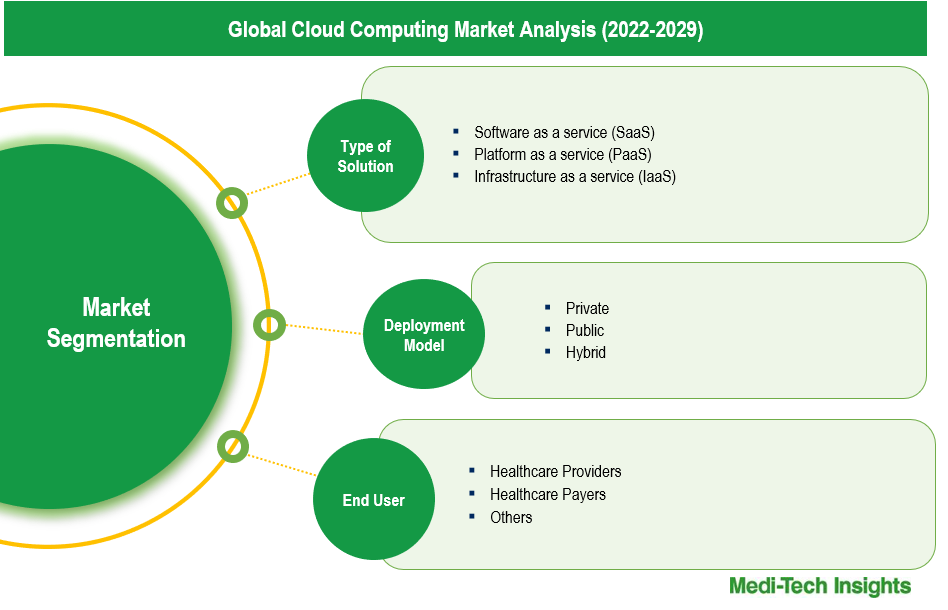
To learn more about this report, download the PDF brochure
Healthcare cloud computing market, by Type of Solution
In the healthcare cloud computing market, Software as a Service (SaaS) is the largest segment due various factors such as ease of deployment, cost efficiency, among others. These solutions reduce upfront capital expenditures by offering a subscription-based pricing structure and are continually updated to meet regulatory compliance, such as HIPAA. Additionally, SaaS solutions are scalable, allowing healthcare organizations to adjust their usage based on needs without significant IT infrastructure investment. While Platform as a Service (PaaS) and Infrastructure as a Service (IaaS) are valuable for specific development and infrastructure needs, SaaS' broad applicability and user-friendly nature make it the dominant segment in the healthcare cloud computing market.
Healthcare cloud computing market, by End User
Hospitals and healthcare systems are the largest market segment in healthcare cloud computing due to their extensive and complex data management needs. These large institutions handle vast amounts of patient data and administrative functions, making scalable cloud solutions ideal for managing and integrating this information.
Key players are focusing on inorganic growth strategies to establish their foothold in the market
Players operating in this market are adopting both organic and inorganic growth strategies. Inorganic growth strategies such as partnerships/collaborations are some of the key strategies adopted by market players to promote use cloud computing within healthcare and thereby enhance their presence. For instance,
- In September 2024, Nova Scotia Health partnered with Google Cloud to implement AI-driven solutions through cloud infrastructure. By leveraging Google Cloud’s advanced capabilities like natural language processing (NLP) and AI for healthcare, this partnership is expected to improve patient care, streamline administrative workflows, and enhance clinical decision-making
- In July 2024, GE Healthcare partnered with Amazon Web Services (AWS) to develop generative AI models aimed at enhancing healthcare operations, including data analysis, diagnostics, and workflow optimization. This collaboration leverages AWS’s cloud infrastructure, particularly Amazon Bedrock, to integrate advanced AI solutions, positioning it as a key effort in the cloud computing market for healthcare
- In Oct 2023, AWS collaborated with the Indian government to create digital health IDs and longitudinal health records, storing patient data on a centralized cloud platform. By integrating platforms like CoWIN and Arogya Setu with AWS cloud infrastructure, the initiative will streamline healthcare records and offer scalable, secure cloud-based solutions for managing health data from birth to end of life
Competitive Landscape
The global healthcare cloud computing market is marked by the presence of players such as Google, Microsoft, Amazon, Athenahealth, NTT DATA, IBM, Salesforce, DXC Technology, Oracle, and Progress Software, among others.
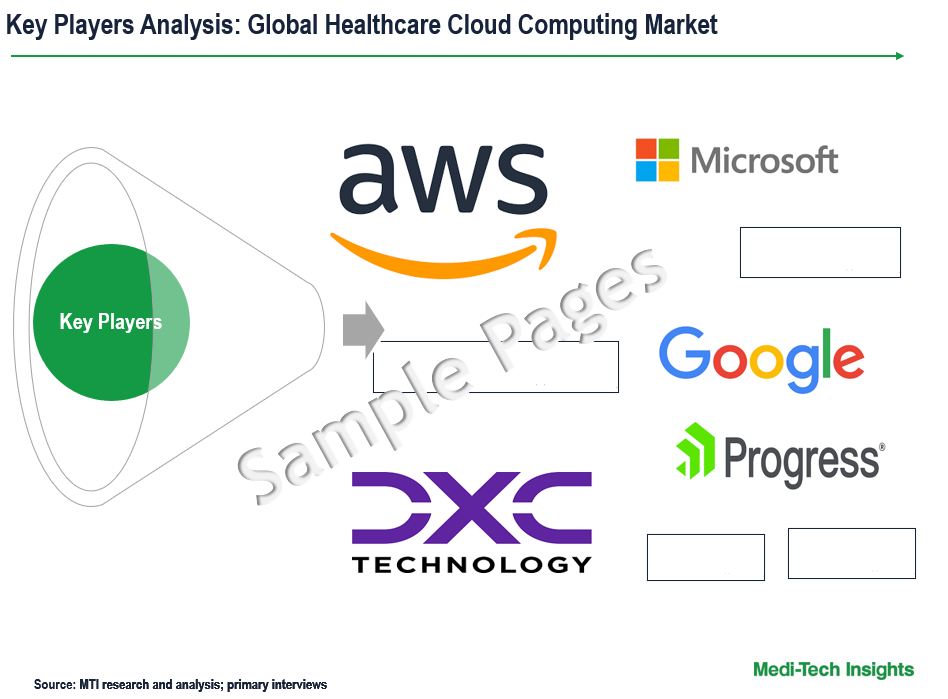
Get a sample report for competitive landscape analysis
Future Outlook of the Healthcare Cloud Computing Market
The healthcare cloud computing market is expected to gain further momentum in the coming years due to growing adoption of health IT technologies, and various organic and inorganic growth strategies followed by the players to advance in the field.
Market Scope
|
Report Scope |
Details |
|
Base Year Considered |
2023 |
|
Historical Data |
2022 - 2023 |
|
Forecast Period |
2024 - 2029 |
|
Growth Rate |
CAGR 15-17% |
|
Segment Scope |
Type of Solution, Deployment Model, End User |
|
Regional Scope |
|
|
Key Companies Mapped |
Google, Microsoft, Amazon, Athenahealth, NTT DATA, GE Healthcare, IBM, Salesforce, DXC Technology, Cerner, and Progress Software |
|
Report Highlights |
Market Size & Forecast, Growth Drivers & Restraints, Trends, Competitive Analysis |
Key Strategic Questions Addressed
-
What is the market size & forecast for the Global Healthcare Cloud Computing Market?
-
What are the historical, present, and forecasted market shares and growth rates of various segments and sub-segments of the Global Healthcare Cloud Computing Market?
-
How has COVID-19 impacted the Global Healthcare Cloud Computing Market?
-
What are the major growth drivers, restraints/challenges impacting the market?
-
What are the opportunities prevailing in the market?
-
What is the investment landscape?
-
Which region has the highest share in the global market? Which region is expected to witness the highest growth rate in the next 5 years?
-
Who are the major players operating in the market? What is the competitive positioning of key players?
-
Who are the new players entering the market?
-
What are the key strategies adopted by players?
- Introduction
- Introduction
- Market Scope
- Market Definition
- Segments Covered
- Regional Segmentation
- Research Timeframe
- Currency Considered
- Study Limitations
- Stakeholders
- List of Abbreviations
- Key Conferences and Events (2023-2024)
- Research Methodology
- Secondary Research
- Primary Research
- Market Estimation
- Bottom-Up Approach
- Top-Down Approach
- Market Forecasting
- Executive Summary
- Healthcare Cloud Computing Market Snapshot (2023-2029)
- Segment Overview
- Regional Snapshot
- Competitive Insights
- Market Overview
- Market Dynamics
- Drivers
- Need to reduce growing healthcare cost
- Rising adoption of electronic health records (EHRs) and health information technology (HIT) systems
- The healthcare industry's shift towards value-based care
- Growing investment in healthcare IT
- Restraints/Challenges
- Interoperability and integration challenges
- High implementation and maintenance costs
- Switching from legacy systems presents a significant challenge
- Opportunities
- Emerging markets
- Expanding telemedicine and remote patient monitoring services
- Key Market Trends
- Drivers
- Unmet Market Needs
- Industry Speaks
- Market Dynamics
- Global Healthcare Cloud Computing Market Size & Forecast (2022-2029), By Type of Solution, USD Million
- Introduction
- Software as a service (SaaS)
- Platform as a service (PaaS)
- Infrastructure as a service (IaaS)
- Global Healthcare Cloud Computing Market Size & Forecast (2022-2029), By Deployment Model, USD Million
- Introduction
- Private
- Public
- Hybrid
- Healthcare Cloud Computing Market Size & Forecast (2022-2029), By End User, USD Million
- Introduction
- Healthcare Providers
- Healthcare Payers
- Others
- Global Healthcare Cloud Computing Market Size & Forecast (2022-2029), By Region, USD Million
- Introduction
- North America Healthcare Cloud Computing Market Size & Forecast (2022-2029), By Country, USD Million
- US
- Market Size & Forecast, By Solution Type (USD Million)
- Market Size & Forecast, By Deployment Model (USD Million)
- Market Size & Forecast, By End User (USD Million)
- Canada
- Market Size & Forecast, By Solution Type (USD Million)
- Market Size & Forecast, By Deployment Model (USD Million)
- Market Size & Forecast, By End User (USD Million)
- Europe Healthcare Cloud Computing Market Size & Forecast (2022-2029), By Country, USD Million
- UK
- Market Size & Forecast, By Solution Type (USD Million)
- Market Size & Forecast, By Deployment Model (USD Million)
- Market Size & Forecast, By End User (USD Million)
- Germany
- Market Size & Forecast, By Solution Type (USD Million)
- Market Size & Forecast, By Deployment Model (USD Million)
- Market Size & Forecast, By End User (USD Million)
- France
- Market Size & Forecast, By Solution Type (USD Million)
- Market Size & Forecast, By Deployment Model (USD Million)
- Market Size & Forecast, By End User (USD Million)
- Italy
- Market Size & Forecast, By Solution Type (USD Million)
- Market Size & Forecast, By Deployment Model (USD Million)
- Market Size & Forecast, By End User (USD Million)
- Spain
- Market Size & Forecast, By Solution Type (USD Million)
- Market Size & Forecast, By Deployment Model (USD Million)
- Market Size & Forecast, By End User (USD Million)
- Rest of Europe
- Market Size & Forecast, By Solution Type (USD Million)
- Market Size & Forecast, By Deployment Model (USD Million)
- Market Size & Forecast, By End User (USD Million)
- Asia Pacific (APAC) Healthcare Cloud Computing Market Size & Forecast (2022-2029), By Country, USD Million
- China
- Market Size & Forecast, By Solution Type (USD Million)
- Market Size & Forecast, By Deployment Model (USD Million)
- Market Size & Forecast, By End User (USD Million)
- Japan
- Market Size & Forecast, By Solution Type (USD Million)
- Market Size & Forecast, By Deployment Model (USD Million)
- Market Size & Forecast, By End User (USD Million)
- India
- Market Size & Forecast, By Solution Type (USD Million)
- Market Size & Forecast, By Deployment Model (USD Million)
- Market Size & Forecast, By End User (USD Million)
- Rest of Asia Pacific
- Market Size & Forecast, By Solution Type (USD Million)
- Market Size & Forecast, By Deployment Model (USD Million)
- Market Size & Forecast, By End User (USD Million)
- Latin America (LATAM) Healthcare Cloud Computing Market Size & Forecast (2022-2029), USD Million
- Market Size & Forecast, By Solution Type (USD Million)
- Market Size & Forecast, By Deployment Model (USD Million)
- Market Size & Forecast, By End User (USD Million)
- Middle East & Africa (MEA) Healthcare Cloud Computing Market Size & Forecast (2022-2029), USD Million
- Market Size & Forecast, By Solution Type (USD Million)
- Market Size & Forecast, By Deployment Model (USD Million)
- Market Size & Forecast, By End User (USD Million)
- China
- UK
- US
- Competitive Landscape
- Key Players and their Competitive Positioning
- Market share analysis/Key players rankings (2024)
- Key players comparison
- Key Strategies Assessment, By Player (2022-2024)
- New Product/Service Launches
- Partnerships, Agreements, & Collaborations
- Mergers & Acquisitions
- Geographic Expansion
- Key Players and their Competitive Positioning
- Company Profiles*
(Business Overview, Financial Performance**, Products/Services Offered, Recent Developments)
- Microsoft
- Amazon (AWS)
- Athenahealth
- NTT DATA
- IBM
- Salesforce
- DXC Technology
- Oracle
- Progress Software
- Other Prominent Players
The study has been compiled based on extensive primary and secondary research.
Secondary Research (Indicative List)
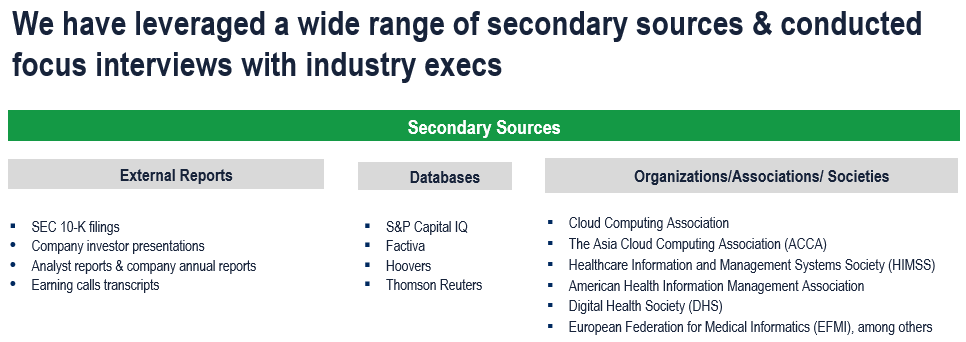
Primary Research
To validate research findings (market size & forecasts, market segmentation, market dynamics, competitive landscape, key industry trends, etc.), extensive primary interviews were conducted with both supply and demand-side stakeholders.
Supply Side Stakeholders:
- Senior Management Level: CEOs, Presidents, Vice-Presidents, Directors, Chief Technology Officers, Chief Commercial Officers
- Mid-Management Level: Product Managers, Sales Managers, Brand Managers, Business Development Managers, Consultants
Demand Side Stakeholders:
- Stakeholders in Hospitals, Pharmacies, Physician's Clinics & Offices and health insurance companies/payers
Breakdown of Primary Interviews
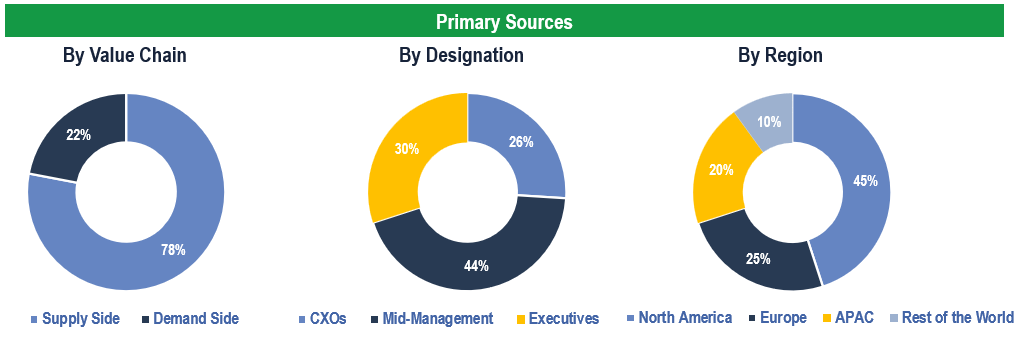
Market Size Estimation
Both ‘Top-Down and Bottom-Up Approaches’ were used to derive market size estimates and forecasts.
Data Triangulation
Research findings derived through secondary sources & internal analysis were validated with Primary Interviews, Internal Knowledge Repository, and Company Sales Data.

